[FIGURE 1]
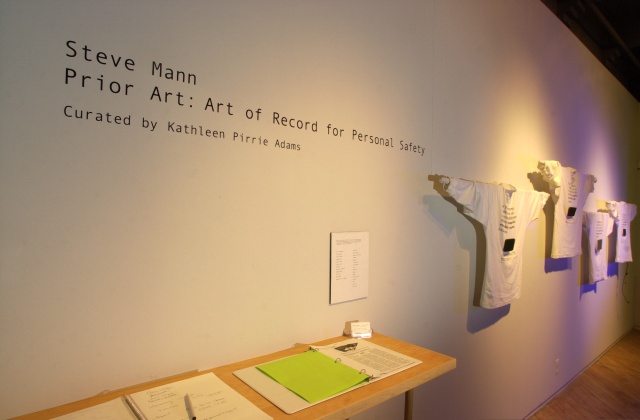
Caption: This exhibit pertains to the use of the patent office as a venue for social commentary.
Prof. Steve Mann and Dr. Stefanos Pantagis
The taboo of sex has largely been left behind as popular television shows take us behind bedroom doors. Yet the privacy of the bathroom remains as the final frontier in a world connected with fiber optics, radio frequency ID tags, mass transit, and "intelligent" buildings in which we live and work. Bathroom users are now on the verge of being watched, not merely by voyeuristic "toiletcams", or management's hidden surveillance cameras, but by the ubiquitous computing and commonly accepted telematics of the all seeing electric eyes, all the more insiduous because of an implied "here to help us, not hurt us" ideal. Surveillance technology, with infrared sensor arrays connected to remote computer systems, is evolving toward systems that engage in more than just automatic flushing.
The Safe Bath [1], research project was part of an inquiry into modern efforts to make the bathroom safer, cleaner, and interactive. If we fall down, or if we are in danger of drowning, someone will remotely know. Home security systems already in place will converge with the same kind of technologies used in public interactive bathrooms. Meet the multimedia toilet, tub, sink, shower, bath, spa, waterpark, or pool, with the latest in immersive multimedia technology that reacts to our needs, wants, or emergencies ranging from automatic flushing to computer-aided drowning detection [2].
Decon gallery, located in downtown Toronto [3] has been the site for a series of theatrical explorations in societal dilemmas and conflicts with technology. Typically the exhibits coincide with a pre-event discussion, or DECONference, that emphasizes taking apart the concepts holding our society and world together. Events to be analyzed typically pertain to a rapidly changing world since the fall of the Berlin wall, the rise of terrorism, and the aftermath of a vacuum created by the end of a balance of power that was left in that void. With the terror of "911" (2001 September 11th) and subsequent anthrax attacks, a new social tempo has created an emphasis on security in the "Osaddam Bush Laden" era. As the feudal lords promised feudal protection in exchange of servitude, we quest for safety given the horrors of bioterror. Events and exhibits at Decon Gallery, included ``Anthrax theatre'' (dehumanizing decontamination drama), various brainwave concerts (or DECONcerts, as they were called), Telematic Tubs Against Terror [4], and explorations into regarding personal borders and empowerment/deempowement.
Decon is derived from the words (De)contamination, (De)constructionism, and (De)consciousness, in particular, stream-of-deconsciousness [5].
The goal of this series of exhibits and events is a search for the language of invention and the understanding of our world by examining the history of interconnectivity and communication: from the primordial desire to invent, to the existential pleasure of the engineer [6], to the childish curiosity of the scientist, to the passionate creativity of the artist, towards awareness of a collective stream-of-(de)consciousness in a multi mediated world.
Leading up to this series of exhibits and events,
in combining art, science, and technology, a new art form was developed
through the use of the patent office as a form of social commentary [7].
[FIGURE 1]

Caption: This exhibit pertains to the use of the patent office as a
venue for social commentary.
The inventions explored in Prior Art laid the groundwork for understanding a problem context (e.g. the April 1, 2000 patent, CA2303611 explored the loss of civil liberties that might follow an anthrax attack by mail), whereas now we must find a solution.
While artificial intelligence aims to automate or replace human activity, the proposed solution is Humanistic Intelligence (HI) that actualizes the capabilities of the body and mind, to form an intelligent control system where user is integrated with a machine-biologic feedback network. The net sum is a physiologic "free spirit" that sets thought and action into being.
HI's "first principle" begins with the "individual's" perspective.
For example, Vicarious Soliloquy begins with the EyeTap [8] device that
captures images worn by an individual with visual gaze as
reference, recreating the inner dialog of memory.
[FIGURE 2]
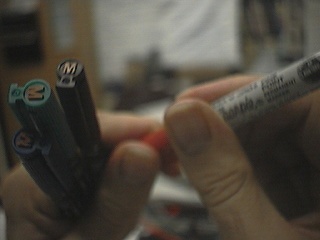
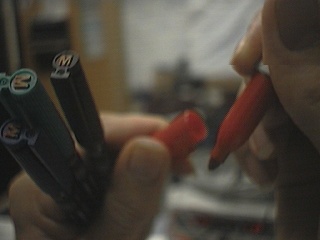
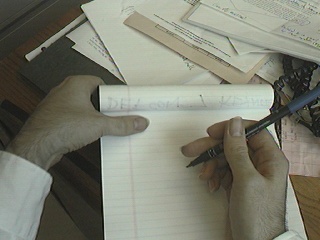
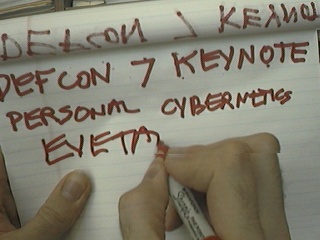
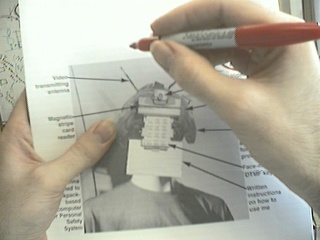
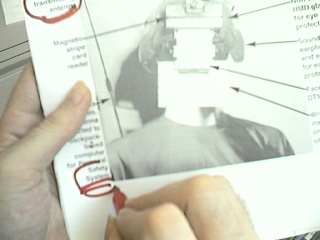

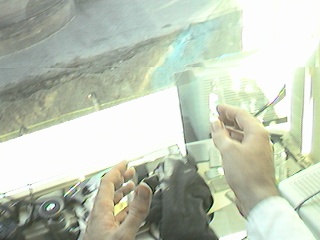
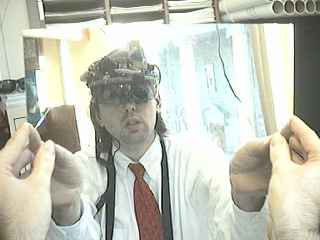
Caption: Downsampled frames taken from a Vicarios Soliloquy motion picture
sequence (the Keynote Address from DEFCON 7). Vicarious Soliloquy is a new
cinematographic genre characterized by a true first--person "EyeTap"
perspective.
EyeTap is a visual memory prosthetic and electric eyeglasses that create computationally mediated environments, and with EyeTap, rational judgments of key patterns within the natural and social world are made: photo-memories that are part of an extended self available to others in cyberspace so that persons can see from the wearer's eye gaze perspective. Vicarious Soliloquy represents this individualistic photojournalism through a poetic/artistic image processing of ones lifelong cyborglog ("glog" [9]) shared with others. Visual Vicarious Soliloquy also preserves the human dignity of solitude and privacy in a world of constant invasion and un-bordering of our humanistic existence and freedom (for example, the electric eyeglasses filter out unwated advertisement and other visual detritus). EyeTap is an invitation towards a personal and public diary that liberates, providing the personal linguistics to communicate a sequence of imaged events to investigate the forensics of freedom lost, a compassionate truth finder that investigates the murder of the human soul [10].
Deconism begins with understanding first the individual and the individual's relationship to solitude and privacy. Encapsulating devices like shoes, clothing, and EyeTaps, both delineate and connect the individual from and to the surrounding technological landscape of both communal connectivity and institutionalized bureaucracy. Clothing is a building built for a single occupant. Such "architecture-of-one" defines the border of the individual as sovereign nation.
Computational clothing sets forth a framework for reflectionism [11]. Reflectionism brings into awareness the unbalance of power between individuals and institutional or governmental surveillance. The surveillance superhighway imposes speed limits upon us, and requires us to wear our driver's licenses, walking licenses, breathing licenses, and living licenses (permission to drive, walk, breathe, live, etc.). The issue of balance of power was traditionally between nation states. Now, with dissolved borders and the speed of communication and travel, balance of power increasingly becomes person versus larger institution, i.e. government and corporation ("covernment"), health care system, etc.. Reflectionsim's goal is to expose the architects and those deliberately or inadvertently participating in creating and maintaining the Surveillance Superhighway to question the disorientating practices in a Socratic method removed of Plato's dogma. This method, which turns the tables against institutions and allows the individual to balance the invasion of privacy and solitude with the ability to counter surveillance, is referred to as sousveillance [12].
Civilians caught in a chemical, biological or nuclear strike area could face "unsavory" action as police battle to maintain order, officers' representatives have warned.The Police Federation annual conference in Blackpool was told "very unsavoury..." action could be needed to control crowds because of a shortage of officers trained to deal with an unconventional attack.
Bob Elder, chairman of the constables' central committee, said the government had not made clear how important it would be to keep the public inside a cordon after an attack. ... He added: "The natural reaction from the public caught up in such an incident will be to get as far away from the scene as possible. ... immediately surrounding the scene, known as the "hot zone", would have an inner and outer cordon, with mobile shower units. [13]
Moreover, with the threats of communicable diseases, the horrors of mass evacuation, mass stripdowns, and mass detention are all too eminent:
the three foreclosed ferryboats anchored off the city's port can be an ideal quarantine station for the moment. There is the initial proposal to use an abandoned building at the Zamboanga City Medical Center as a quarantine station. ... The Mindanao Sanatorium could be another choice. Its positive factor is that it has medical faculties and used to isolation practices as in the treatment of lepers. ... There are even soldiers assigned there who can be ordered to shoot down any SARS infected victim who might try to escape [14]Four new detention camps were recently established in China, and a more permanent detention facility was built in only eight days:
Beijing (AP) - Beijing didn't have enough beds for SARS patients in its hospitals, so it built a new one - in eight days. ... construction workers put the finishing touches Wednesday on the new 1,000-bed facility. ... ringed by a 15-foot-high red brick wall ... The facility is made of prefabricated panels. At the gate, two dozen members of the paramilitary People's Armed Police stood guard, dressed in green uniforms and white gauze face masks. A sign on a nearby guard hut told drivers to, "Stop, Roll up Windows, Prepare to Be Disinfected." [15]
Around the world, undesirables, such as homeless people, are being rounded up and sent to detention camps:
Taipei City Government rounded up around 75 homeless people and took them to Wukang military base on a remote hill in Tachih, Taipei City. ... The city government mobilized engineers and constructors last Thursday and in just four days they refurbished a deserted military base and set up quarantine camps for the homeless. Police from a number of different stations in Wanhua reported to the search teams, who drove around in police cars moving swiftly from one location to the next. ... When the team got a group of around 3-5 homeless they would have a van take the homeless to the quarantine camp. [16]
This editorial collection is a sampling of real time power of governments to classify and isolate people during an epidemic. Deempowerment by displacing persons from their communities, homes, clothes, personal effects, and selves, was examined in an inverse Brechtian play act. During Anthrax theatre, the audience members become the actors undergoing the process of Decontamination. The Decon officers, observant of the acting audience, themselves are confronted with the thought provoking consciousness of being an audience evaluating the spontaneous control and uncontrol of the events. The principles of humanistic intelligence and the interplay of surveillance with sousveillance, fuels a reversed Brechtian educational process. The damage of blitzkrieg propaganda and revisited concentration camp nightmares are contextualized in the present-day maintaining of an integrity of the sovereign nation of one. Understanding our cyborg extensions leads to maintaining control of privacy and solitude in the postpostcyborg era by maintaining (or destroying) not only physical barriors that determine selfhood, but also the spiritual and soulful integrity that determines purpose and freedom confronted within the calibration of our mechanical extensions. The potential outcomes of Anthrax theatre are multiple ranging from altruistic heroism and compassion to the Brechtian dark side.
An example of a current disproportion of sensory input begins with advertisers as projectors of unwanted images within the consciousness. Theft of biological machine cycles from the mind causes a loss of part of ones self leading to spiritual demoralization and acceptance of the new cults of ethics based only upon desire, leading us to the breeding grounds of ignorance via the eye candy of Flash (Flascism). This evolves into a Machiavellian surveillance state. The haze of magical mystery, miracles of technology and the comfort of authority lead us to the escape from freedom. Revenge, plots and counter plots of power attainment replaces the meritocracy of hard work, character, and human creativity. Maximizing pleasure above all else evolves from the self-centered emotional greed that becomes the new monetary unit. There is comfort and security within a societal structure that provides plenty. The rules of mediocrity are unwritten and unspoken but dictate a power structure focused on maintaining a status quo of stability in income, employment, and social standing. This system brings with it a detachment of persons from their ability for compassion, removing from them the ability to see from another's perspective. With this, the ability to be more efficient in caring out orders correlates with an increase in callousness and aggression. Institutions that handle large numbers of persons such as airports, hospitals, nursing homes, and department stores demonstrate the efficiencies of handling persons and crowds in a cold mechanistic manner that makes the above-mentioned SARS detention camps seem to fit within the bell curves of conformity and the determinism of bondage.
Such events set an appropriate context for various forms of Telematic Tubs and Submersive Multimedia Bapterrorism events that often followed the main event. One such Submersive Multimedia event was set aside for only people who could prove that they did not have an odd social security number.
This and various other immersive/submersive/subversive multimedia events were explored through what we call a ``quison''. A quison is an inverse quarantine facility, not for the treatment of persons suspected of having come in contact with someone suspected of carrying disease, or of having come into contact with contaminated individuals, nor is it intended for the interrogation of persons who might have knowledge of suspected criminal activity.
CECI N'EST PAS UNE PRISON. The ``quison'' is not a prison!
Nor is it quite exactly the same as a beach resort or spa facility, although there are close parallels. The quison has no walls, because the quison is for human cells, not jail cells. In quison, we are free! We are free of disease, free of contraband, free of weapons, and free of crime. (But do freedom from disease, contraband, and crime come at the expense of liberty?)
In quison, safety extends beyond disease. To make everyone feel safe and secure, they are cleansed of both contraband and contrary ideas. People choose to come to quison in order to be together in similar mind and spirit, and, perhaps, to be free of Obedience Deficit Disorder (ODD), a hypothetical medical disorder indicated by the presence of a 1, 3, 5, 7, or 9 appearing in the last digit of one's social security number.
Submersive Multimedia engendered a series of explorations, and investigations, within a quison environment. The quison was constructed on the topmost two floors and roof of Decon Gallery (330 Dundas Street West, Toronto, Ontario, directly across the street from the Art Gallery of Ontario). Various embodiments of the quison were also presented at the International Symposium of Electronic Art (ISEA), in 2002 [17].
The quison explored issues of cyborg identity in the anthrax age, as well as the idea of a decon resort and the obsession with cleanliness and the body:
The quison was initially presented as a prestigious club, often as a series of exhibits having exclusive invitation. On many occasions, patrons were initially required to apply for an invitation if they wished to attend the events, or to be part of the inner circle. Successful response to the invitation often required disclosure of personal information. Personal information was later used in an arbitrary manner, in the exhibit, that eventually led people to understand the satire.
Highly exclusionary clique-like cleansing baths explored public vulnerability. Ethnic cleansing of the body emphasized the fragility of humanity. From swim meet to swim meat, the body became the subject of dehumanizing machinery rather than the integrated cyborg technology afforded by clothing of our own choice.
In some of the events, the gender segregation called to mind not only the way cattle are often treated (almost always separated by gender) but also the sexualized stereotypes of the power dynamics alleged to be implicit in the very machinery of surveillance. This gendrist interplay of feminist versus masculist, carries with it the overtones of "to-be-looked-at-ness" versus "to-look-at-ness".
The networked shower as a male or female (gender) construct eventually gives rise to the matrix bodies floating the communal cyberspace bathtub, stripped of their own technological prostheses (clothing, eyeglasses, wearable computers, etc.), and then re-connected in a collective stream-of-(de)consciousness using brainwave electrodes.
In the era of technoacheivment in medicine, Anthrax bioterror, and epidemic SARS, the revisitation of Plato's caves sets the thematic tempo of understanding telematic tubs. The bioinformatics of alphawaves via analysis of relaxation as biofeedback interconnectivity reveals to the individual personal relaxation within the communal bath, personal hysteria of "fear of being seen in a bathing suit" as a challenge to relaxation.
Often the brainwave electrodes were used to control lighting. For example, in the Optical Erection [18], arousal taps into the limbic, supratentorial occipital intracranial currents that simultaneously cycle into the neurohormonal response of a "flight or fright" reaction.
Sitting in bubbling water, in a tub with multimedia and internet capacity, provides a system of communal interconnectivity: it is a reference zone to contemplate Plato's caves in the setting of a SARS quarantine, allowing for close interpersonal bonding while experiencing the healing powers of internet immersion key to human discourse and connecting with remote persons outside a quison lockdown zone.
The process of undergoing the baptismal telematic immersion is analogous to the decent into Plato's cave and escaping back outside, discovering that biofeedback, an unknown mechanism to Plato, could be used by those trapped in the cave to communicate with the outside world by manipulating the shadows themselves. The computer-controlled projectors that were often used to shine onto the tub's translucent surfaces created perceptual prisms of a new language that got at the truth behind quisonary illusions. The unanticipated discovery of truth by the "cave imprisoned" undermined the controlling privileged ones who come and go as they please, and who use both surveillance and broadcast-only media as a system of maintaining status quo via the shadows of intellectual imprisonment.
In many of our experimental setups we found that mounting all the lights
outside the building, having them shine in through the windows,
created the most natural and pleasing effect:
[FIGURE 3]

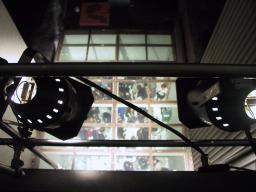


Here outdoor waterproof lights shining in through the glass ceiling, at Decon Gallery, were mounted on a catwalk some 30 feet above the glass ceiling.
On rainy evenings, the effect was particularly interesting, wherein the warmth of the light contrasted the rain. Shadows of running rain, like teardrops in the rain, upon the skin of the building, emerged with wavelike periodicity.
Running waves of light, controlled by brainwaves, crossed the room like the caustics (curves of infinite brightness) at the bottom of an outdoor pool on a sunny day.
The mixture of nature (rain) and body (brainwave control of the lights) created a nice modulation of brainwaves and waterwaves under the transparent skin of glass that made the building's envelope.
Moreover, as a practical matter, we found that when the light is very pleasant and natural, less light is needed in order to achieve a nice environment. The long shadows, localized bright-spots, and window-frame effect create an environment that feels warm and pleasant.
The various brainwave deconcerts resulted in collaborative brainwave response. Biofeedback loops became collective multimedia environments (e.g. collective musical instruments, collective control of lighting, visual art, and the like), allowing participants to invent collective stream-of-deconsciousness as a new genre.
In the most recent brainwave deconcert, two persons with significant brain injury, who were confined to their homes, were able to participate remotely and become part of a performance and concert of young active college students.
The first such person had advanced vascular Parkinson's and the second had experienced a stoke after brain herniation from a subdural hematoma. Both persons where limited in terms of physical and verbal abilities from their prospective injuries. Both survived prolonged hospitalization, marginilazation from society and a struggle against the tyranny of the mediocre systematic manner of illusions to cover up the truth outside the "cave".
The ability to remotely, through brainwaves, become part of an immersive audiovisual experience, highlighted the diffusionism of the human spirit in the reality of human freedom otherwise lost to chronic illness. Many of the challenges experienced in reality within the hospital system intersect with what was discovered during the DECON events: the ability for two individual trapped by illness to interact with young college students in philosophic discourse was liberating and highlights the aesthetics of compassion.
New inventions may liberate or subjugate. When advertising and surveillance are combined, we have both input and output, but not in a feedback loop that liberates. Information and invention built generation to generation, of shared knowledge accumulated in measured harmony between aesthetic input and output, however, can lead towards a balance bettering humanity. The printing press, for example, has at least part of the time given rise to a phenomena, with harmonized balance, a transformed and educated multiple many, but with imbalance, input only propaganda, with inability to see the others humanity, and hence the intolerant disregard of personal borders and hence, wars. The future of HI versus AI has this dilemma: if we allow balance of inout and output, then we can thrive and we can have more persons participating in the humanistic feedback loop toward the freedom we cherish, in the face of inventions that otherwise seek to limit input or output.
[1] Intelligent Bathroom Fixtures and Systems: EXISTech Corporation's Safebath
Project, Steve Mann, ISAST LEONARDO, Vol. 36, No. 3, pp. 207-210, 2003.
[2] "...underwater cameras to spot drowning bathers.... We want to make
recreation as pleasurable and safe as possible....
In the Netherlands about 10 people drown every year in public baths."
Safer Swimming with Poseidon Cameras,
http://www.rnw.nl/science/html/drowning000515.html
15 May 2000, Liesbeth de Bakkerd
[3] http://wearcam.org/deconism/index.htm
[4] "Telematic Tubs Against Terror", Steve Mann, To appear, Leonardo, 2003.
See also "The Deconism Gallery's 'hysterical relaxation' tubs symbolize
our experience in the womb", Kelly Nestruck, National Post, 2003 August 12.
[5] "The Post-Cyborg Path to DECONism", Steve Mann, CTheory, 2003 Feb. 8,
http://wearcam.org/ctheory/index.htm
[6] "The Existential Pleasures of Engineering", Samuel Florman,
Thomas Dunne Book, April, 1996, ISBN: 0312141041.
[7] http://wearcam.org/envirotech/decon2001apr1/prior_art.htm
[8] http://eyetap.org
[9] http://wearcam.org/glog.htm
[10] http://www.antipsychiatry.org/gandhi.htm
[11] "New Tactics for Deconstructing the Video Surveillance Superhighway",
Steve Mann, Leonardo, Vol. 31, No. 2, pp. 93-102, 1998
[12] "Sousveillance: Inventing and Using Wearable Computing Devices for Data
Collection in Surveillance Environments", Steve Mann, Jason Nolan, and
Barry Wellman, Surveillance & Society 1(3): 331-355,
http://www.surveillance-and-society.org/articles1(3)/sousveillance.pdf
[13] "Dirty bomb victims 'may be shot'", John Innes, The Scottsman,
Wed 14 May 2003
http://www.propagandamatrix.com/dirty_bomb_victims_may_be_shot
[14] "Floating Quarantine station okay?", Lino Santos,
Sun Star, Sunday, May 04, 2003.
http://www.sunstar.com.ph/static/zam/2003/05/04/oped/lino.santos.html
[15] "Beijing builds a 1,000-bed SARS hospital", Christopher Bodeen,
Associated Press, Publication date: 05/01/2003, San Francisco Examiner,
http://www.examiner.com/sfx/templates/printer.jsp?story=n.CHINASARS.0501w
[16] "Taipei rounds up homeless in Wanhua", Hung-fu Hsueh, eTaiwan News,
2003-05-13,
http://www.etaiwannews.com/Taiwan/2003/05/13/1052787938.htm
[17] ``Decontamination, Surveillance and Ready Made Martial Law in the Anthrax
Age'', International Symposium on Electronic Art (ISEA 2002),
October 27-31, Japan, Steve Mann, Marc Bohlen, Julia Scher, Sara Diamond,
and Natalie Jerimijenko.
[18] "Telematic Tubs Against Terror", Steve Mann, To appear, Leonardo, 2003.
describes the ``optical erection''
as a visual involuntary indicator of arousal computed through
brainwave surveillance and displayed upon each bather in
response to the visual stimulus they receive from other bathers.